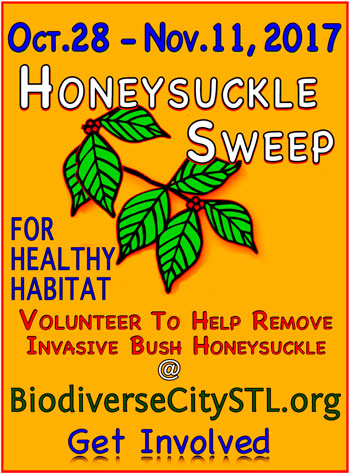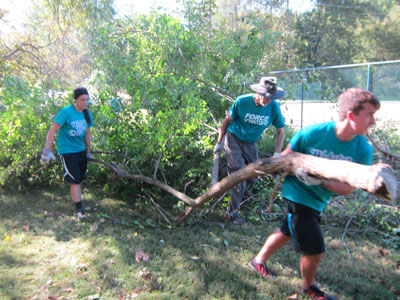This dreadful bush’s berries are glossy red, its leaves are still green and clinging, and the ticks and chiggers are (mostly)

gone from the woods it infests. It’s time again to grab a tool and VOLUNTEER to hack Bush Honeysuckle out of our region’s parks and waterways.
Bush Honeysuckle (Lonicera maackii) has become this region’s most visible invasive plant problem. In spring, it leafs out before our native bushes, trees and flowers, shading and crowding out the plants that should be thriving here. Imported in a time when the garden industry and conservation agencies were not fully factoring in ecological consequences, this plant is totally out of place. It has no natural plant competitors, no natural controls from insects, animals or diseases. Lacking any of these natural deterrents, Bush Honeysuckle does what all plants do: it grows. When one plant can so easily out-compete our native species, biodiversity is seriously endangered, for plants, birds, bugs, aquatic life and animals – including us.
In fall, those plump scarlet berries seem like an asset for our bird friends, as berries on a bush should be. In the part of the world Bush Honeysuckle came from, its sugary berry menu is seasonally correct. Here the bush is serving up a soda-pop diet at the time of year when birds need fats for migration and overwintering. But birds love berries! Those little flyers gobble and poop, seeding zillions of new honeysuckle bushes, everywhere. That’s an invasion.
Honeysuckle Sweepers are on the move too! Since spring 2016, this bi-annual event coordinates the efforts of many area groups who are working to beat back the bush. The Honeysuckle Sweep for Healthy Habitat concentrates volunteer removal days in a two-week timeframe. The Sweep boosts public education, volunteer recruitment, and results from hacks in public parks, along trails, and on school and business properties. This fall, the Sweep runs from Saturday, October 28 through Sunday, November 12. Events are taking place on weekend mornings and in some weekday and other times, providing a range of volunteering options.

Sweep partners lead hundreds of volunteers each season. They provide tools, safety training, water and snacks. Sweep partners also track data from removal events, which helps drive regional efforts to control invasive species. Honeysuckle Sweep participants learn hands-on the best ways to eradicate this plant. Sweep jobs include cutting and pulling plants, dragging and piling cut brush, and treating cut stumps with targeted herbicide application. Adults and youth can put this experience to work at home, in their neighborhoods, and at schools, workplaces, and community locations.
Some Honeysuckle Sweep events also include re-planting with Missouri native species. A growing number of Sweep sites feature areas that have been ecologically restored after honeysuckle removal. The difference is dramatic! You can see the forest, and the trees, once this landscape-clogging bush is removed.

Honeysuckle Sweep events are being led this fall by: Forest Park Forever, St. Louis Audubon, St. Louis County Parks, Kirkwood Parks, Friends of Emmenegger Park, Missouri Master Naturalist chapters, Wild Ones of St. Louis, Open Space Council, the Katy Land Trust, Missouri Botanical Garden, Shaw Nature Reserve, Greenway Network, and other groups. Visit
www.BiodiverseCitySTL.org for a list of events, details about the issue, and solutions. Sign up to help turn back the Bush Honeysuckle invasion!